Overview
|
A powerful, long duration winter storm brought widespread snowfall amounts of 8 to 24 inches across parts of northeast Minnesota and northwest Wisconsin, with areas around Lake Superior receiving up to 30 inches of snow. A wintry mixture of sleet, freezing rain and snow began Tuesday (December 13th) afternoon and evening, spreading northeast overnight Tuesday night and into Wednesday (December 14th) morning. This first wave of precipitation brought a widespread 6 to 12 inches of snow. We had a break in the snowfall during the day on Wednesday, but it started up again Wednesday night and continued into Thursday (December 15th), bringing another 8-20 inches of snow. This second wave of precipitation was nearly all snow, enhanced by the main upper level low pressure system as it moved close to the area. Lighter snow lingered into Friday and Saturday, December 16th and 17th. A low pressure system developed over eastern Colorado early Tuesday, moved northeast to eastern Nebraska by Wednesday morning, then to east-central Minnesota by Thursday morning, lingering there through Friday before moving off to the northeast Friday night and Saturday. The storm resulted in a long period of poor road conditions, with strong winds causing blowing and drifting snow. There were also widespread power outages, with some people reporting no power for over two days! |
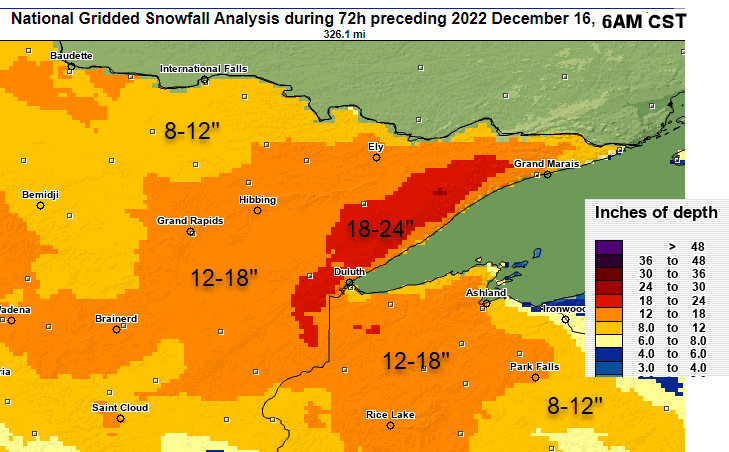 NOHRSC Snowfall Analysis for December 14-16 2022, showing 8-24 inches over the Northland |
|
Notable with this storm was how wet and heavy the snow was, with 3-day liquid equivalent values of 1 to 4 inches. The wet quality of this snow, unusual for winter storms in this area, heavily weighed down trees and power lines. The density of the snowpack also exacerbated the quality of snow to absorb the red end of the visible light spectrum, transmitting the blue end, which led to many folks observing a glacier blue color in holes and cracks in the snow as they cleared it. Because of this blue color, as well as the very wet quality of the snowfall, NWS Duluth has taken to referring to this snow as the Blue Blizzard of 2022. |
|
Snow/Ice
Storm reports plotted on a map
PUBLIC INFORMATION STATEMENT NATIONAL WEATHER SERVICE DULUTH MN 1108 AM CST FRI DEC 16 2022 ...STORM TOTAL SNOWFALL REPORTS... 7S HOUR SNOWFALL REPORTS OF 1 INCH OR MORE ENCOMPASSING THE 2022 MID DECEMBER BLIZZARD. LOCATION AMOUNT TIME/DATE PROVIDER ...MINNESOTA... ...AITKIN COUNTY... TAMARACK 2.5 SE 16.5 IN 0700 AM 12/16 COCORAHS TAMARACK 1.4 SW 14.1 IN 0700 AM 12/16 COCORAHS 7 N MCGREGOR 16.7 IN 0700 AM 12/16 COCORAHS ...CARLTON COUNTY... WRENSHALL 20.9 IN 0800 AM 12/16 UCOOP WRENSHALL 9.7 SSE 17.1 IN 0700 AM 12/16 COCORAHS CARLTON 5.6 NE 29.5 IN 0700 AM 12/16 COCORAHS 3 E WRIGHT 2.7 ESE 16.4 IN 0700 AM 12/16 COCORAHS ...CASS COUNTY... PILLAGER 5.1 N 15.2 IN 0620 AM 12/16 COCORAHS DEER RIVER 6.5 S 11.5 IN 0800 AM 12/16 COCORAHS CASS LAKE 10.9 IN 0800 AM 12/16 COOP HACKENSACK 5.4 NE 9.6 IN 0800 AM 12/16 COCORAHS FEDERAL DAM 0.3 S 9.0 IN 0700 AM 12/16 COCORAHS REMER 11.5 WSW 11.7 IN 0700 AM 12/16 COCORAHS ...COOK COUNTY... LUTSEN 11.8 N 16.3 IN 0800 AM 12/16 COCORAHS GRAND MARAIS 4.4 WSW 16.1 IN 0700 AM 12/16 COCORAHS GRAND MARAIS 4.4 W 16.0 IN 0600 AM 12/16 COCORAHS 10 ESE SEA GULL LAKE 15.8 IN 0800 AM 12/16 BROADCAST MEDIA GRAND MARAIS 6.6 NW 15.5 IN 0700 AM 12/16 COCORAHS TOFTE 4.9 NE 12.5 IN 0700 AM 12/16 COCORAHS HOVLAND 2.8 WNW 11.8 IN 0730 AM 12/16 COCORAHS 3.7 NE SEA GULL LAKE 8.3 IN 0700 AM 12/16 COOP GRAND MARAIS 3.6 E 1.5 IN 0700 AM 12/16 COCORAHS TOFTE 2.1 NE 1.0 IN 0700 AM 12/16 COCORAHS ...CROW WING COUNTY... BRAINERD 11.5 E 16.5 IN 0740 AM 12/16 COCORAHS NISSWA 4.2 ENE 15.8 IN 0800 AM 12/16 COCORAHS CROSBY 1.1 SW 15.3 IN 0630 AM 12/16 COCORAHS FORT RIPLEY 0.8 N 13.7 IN 0700 AM 12/16 COCORAHS BRAINERD 7.7 SSE 12.8 IN 0700 AM 12/16 COCORAHS TROMMALD 6.1 NW 10.9 IN 0800 AM 12/16 COCORAHS BRAINERD 3.5 IN 0700 AM 12/16 COOP ...ITASCA COUNTY... 4 NNW NASHWAUK 19.8 IN 0800 AM 12/16 TRAINED SPOTTER GRAND RAPIDS 6.2 SSW 19.0 IN 0600 AM 12/16 COCORAHS GRAND RAPIDS 6.3 N 18.5 IN 0830 AM 12/16 COCORAHS COLERAINE 0.7 S 18.1 IN 0700 AM 12/16 COCORAHS GRAND RAPIDS 6.1 N 17.9 IN 0700 AM 12/16 COCORAHS 1 W GRAND RAPIDS 17.5 IN 0706 AM 12/16 TRAINED SPOTTER COHASSET 1.5 WSW 17.0 IN 0700 AM 12/16 COCORAHS 3 SW COHASSET 17.0 IN 0700 AM 12/16 PUBLIC 12 N GRAND RAPIDS 16.5 IN 0800 AM 12/16 CO-OP OBSERVER BOVEY 13.4 N 15.7 IN 0649 AM 12/16 COCORAHS SWAN RIVER 0.6 W 14.5 IN 0630 AM 12/16 COCORAHS BIGFORK 7.3 SW 14.4 IN 0700 AM 12/16 COCORAHS MARCELL 0.7 NNW 13.7 IN 0830 AM 12/16 COCORAHS DEER RIVER 3.7 W 12.7 IN 0800 AM 12/16 COCORAHS GRAND RAPIDS 12 N 11.5 IN 0630 AM 12/16 COOP NORTHOME 3 S 10.5 IN 0700 AM 12/16 COOP ...KOOCHICHING COUNTY... INTERNATIONAL FALLS 5.1 SSW 10.5 IN 0700 AM 12/16 COCORAHS BIG FALLS 1.0 N 9.7 IN 0800 AM 12/16 COCORAHS INTERNATIONAL FALLS 0.6 NW 8.8 IN 0700 AM 12/16 COCORAHS ...LAKE COUNTY... FINLAND 0.8 NNE 35.5 IN 0700 AM 12/16 COCORAHS TWO HARBORS 3.6 WNW 30.0 IN 0700 AM 12/16 COCORAHS TWO HARBORS 19.8 N 25.0 IN 0700 AM 12/16 COCORAHS TWO HARBORS 2.1 NW 25.0 IN 0700 AM 12/16 COCORAHS WOLF RIDGE 24.3 IN 0700 AM 12/16 COOP 1 W SILVER BAY 22.6 IN 0800 AM 12/16 TRAINED SPOTTER ELY 25 E 14.3 IN 1000 AM 12/16 COOP TWO HARBORS 0.4 ESE 3.2 IN 0800 AM 12/16 COCORAHS TWO HARBORS 2.3 IN 0700 AM 12/16 COOP ...PINE COUNTY... STURGEON LAKE 7.5 ESE 18.3 IN 0600 AM 12/16 COCORAHS PINE CITY 0.7 SSW 10.5 IN 0700 AM 12/16 COCORAHS ...ST. LOUIS COUNTY... DULUTH 7.9 SW 28.5 IN 0900 AM 12/16 COCORAHS NWS DULUTH 24.2 IN 0600 AM 12/16 COOP BRIMSON 2.0 S 23.8 IN 0800 AM 12/16 COCORAHS DULUTH 11.8 NNE 23.0 IN 0730 AM 12/16 COCORAHS 4 NNW FRENCH RIVER 21.0 IN 0800 AM 12/16 COCORAHS 1 SSE HIBBING 19.4 IN 0800 AM 12/16 TRAINED SPOTTER DULUTH 4.6 NE 18.8 IN 0740 AM 12/16 COCORAHS CHISHOLM 0.7 NW 18.6 IN 0630 AM 12/16 COCORAHS IRON JUNCTION 3.4 NNW 18.5 IN 0800 AM 12/16 COCORAHS HIBBING 11.6 SSW 17.9 IN 0700 AM 12/16 COCORAHS EMBARRASS 17.5 IN 0600 AM 12/16 COOP DULUTH 17.6 NNW 17.5 IN 0700 AM 12/16 COCORAHS DULUTH 1.4 NNW 16.7 IN 0811 AM 12/16 COCORAHS 3.8 S TOWER 16.4 IN 0730 AM 12/16 COOP CANYON 4.6 NNE 16.3 IN 0715 AM 12/16 COCORAHS 5.1 N FLOODWOOD 15.5 IN 0730 AM 12/16 COOP BIWABIK 2.9 NNE 14.8 IN 0800 AM 12/16 COCORAHS WRIGHT 9.2 NNE 14.7 IN 0700 AM 12/16 COCORAHS DULUTH 3.0 NE 14.5 IN 0730 AM 12/16 COCORAHS 2 SSW ELY 14.3 IN 0810 AM 12/16 TRAINED SPOTTER DULUTH 15.4 NNW 14.2 IN 0700 AM 12/16 COCORAHS ELY INTL WOLF CENTER 13.5 IN 0800 AM 12/16 COOP ELY 0.9 WNW 13.4 IN 0700 AM 12/16 COCORAHS ORR 3 E 13.0 IN 0600 AM 12/16 COOP CELINA 2 E 11.0 IN 0900 AM 12/16 COOP KABETOGAMA 10.2 IN 0700 AM 12/16 COOP KABETOGAMA 0.7 SSW 9.9 IN 0700 AM 12/16 COCORAHS COTTON 9.5 IN 0600 AM 12/16 COOP COOK 8NE 8.7 IN 0600 AM 12/16 COOP DULUTH 2.9 NE 8.3 IN 0800 AM 12/16 COCORAHS DULUTH 1.2 SE 4.5 IN 0600 AM 12/16 COCORAHS ...WISCONSIN... ...ASHLAND COUNTY... ASHLAND 3 S 10.5 IN 0800 AM 12/16 COOP ODANAH 1.6 E 5.5 IN 0700 AM 12/16 COCORAHS ...BAYFIELD COUNTY... IRON RIVER 5.0 SSE 25.0 IN 0700 AM 12/16 COCORAHS BAYFIELD 5.1 NNW 19.6 IN 0730 AM 12/16 COCORAHS ASHLAND 9.8 W 17.1 IN 0600 AM 12/16 COCORAHS MASON 11.5 WNW 15.6 IN 0800 AM 12/16 COCORAHS IRON RIVER 5.2 ESE 15.5 IN 0648 AM 12/16 COCORAHS CABLE 10.2 ENE 14.4 IN 0800 AM 12/16 COCORAHS MELLEN 18.6 SW 13.9 IN 0715 AM 12/16 COCORAHS CLAM LAKE 4W 13.9 IN 0715 AM 12/16 COOP BAYFIELD 2.6 WSW 13.1 IN 0730 AM 12/16 COCORAHS 5 S HERBSTER 10.5 IN 0734 AM 12/16 TRAINED SPOTTER BAYFIELD 1.7 SW 10.2 IN 0700 AM 12/16 COCORAHS BAYFIELD FISH HATCHERY 8.8 IN 0800 AM 12/16 COOP WASHBURN 0.8 N 1.0 IN 0700 AM 12/16 COCORAHS ...BURNETT COUNTY... SPOONER 10.6 WNW 15.0 IN 0900 AM 12/16 COCORAHS OAKLAND 9.0 ENE 13.7 IN 0700 AM 12/16 COCORAHS GRANTSBURG 0.6 SSW 11.5 IN 0700 AM 12/16 COCORAHS 7 SW HERTEL 10.9 IN 0700 AM 12/16 COCORAHS GRANTSBURG 0.6 SW (KWIGRANT1 9.2 IN 0734 AM 12/16 COCORAHS ...DOUGLAS COUNTY... SUPERIOR 14.8 S 24.0 IN 0700 AM 12/16 COCORAHS SOLON SPRINGS 1.2 W 20.9 IN 0700 AM 12/16 COCORAHS COZY CORNER 20.5 IN 0800 AM 12/16 COCORAHS POPLAR 2.0 E 17.3 IN 0700 AM 12/16 COCORAHS POPLAR 7.4 SSW 16.0 IN 0700 AM 12/16 COCORAHS SUPERIOR 2.0 WNW 8.5 IN 0730 AM 12/16 COCORAHS 3 N AMNICON FALLS S.P. 8.3 IN 0800 AM 12/16 TRAINED SPOTTER SUPERIOR 3.7 WNW 4.9 IN 0700 AM 12/16 COCORAHS ...IRON COUNTY... MERCER 0.4 N 9.5 IN 0800 AM 12/16 COCORAHS SAXON 3.8 W 9.1 IN 0630 AM 12/16 COCORAHS PENCE 0.1 E 7.5 IN 0600 AM 12/16 COCORAHS MERCER 7.0 NNE 6.8 IN 0700 AM 12/16 COCORAHS HURLEY 5.0 IN 0800 AM 12/16 COOP ...PRICE COUNTY... BUTTERNUT 3 SW 13.0 IN 0600 AM 12/16 COOP BUTTERNUT 5.9 SW 12.9 IN 0700 AM 12/16 COCORAHS 3 W PHILLIPS 11.8 IN 0800 AM 12/16 PUBLIC PHILLIPS 1.3 S 11.7 IN 0600 AM 12/16 COCORAHS PHILLIPS 0.4 SSW 11.2 IN 0800 AM 12/16 COCORAHS BRANTWOOD 7.4 S 10.8 IN 0400 AM 12/16 COCORAHS BRANTWOOD 2.5 S 8.5 IN 0700 AM 12/16 COCORAHS ...SAWYER COUNTY... HAYWARD 4.4 SSE 16.9 IN 0700 AM 12/16 COCORAHS HAYWARD 9.2 NNE 13.8 IN 0700 AM 12/16 COCORAHS HAYWARD 9.7 NE 13.6 IN 0900 AM 12/16 COCORAHS ...WASHBURN COUNTY... SHELL LAKE 4.3 SW 16.3 IN 0744 AM 12/16 COCORAHS SARONA 6.8 ENE 12.6 IN 0800 AM 12/16 COCORAHS SARONA 4.5 NNE 14.1 IN 0800 AM 12/16 COCORAHS 2.0 SE SPOONER 5.0 IN 0700 AM 12/16 UCOOP ...MARITIME STATIONS... SUPERIOR 3.7 WNW 4.9 IN 0745 AM 12/16 COCORAHS SUPERIOR 2 ENE 4.0 IN 1158 PM 12/15 COOP OBSERVATIONS ARE COLLECTED FROM A VARIETY OF SOURCES WITH VARYING EQUIPMENT AND EXPOSURES. WE THANK ALL VOLUNTEER WEATHER OBSERVERS FOR THEIR DEDICATION. NOT ALL DATA LISTED ARE CONSIDERED OFFICIAL.
Media
Blue Snow photos, and other snow statistics!
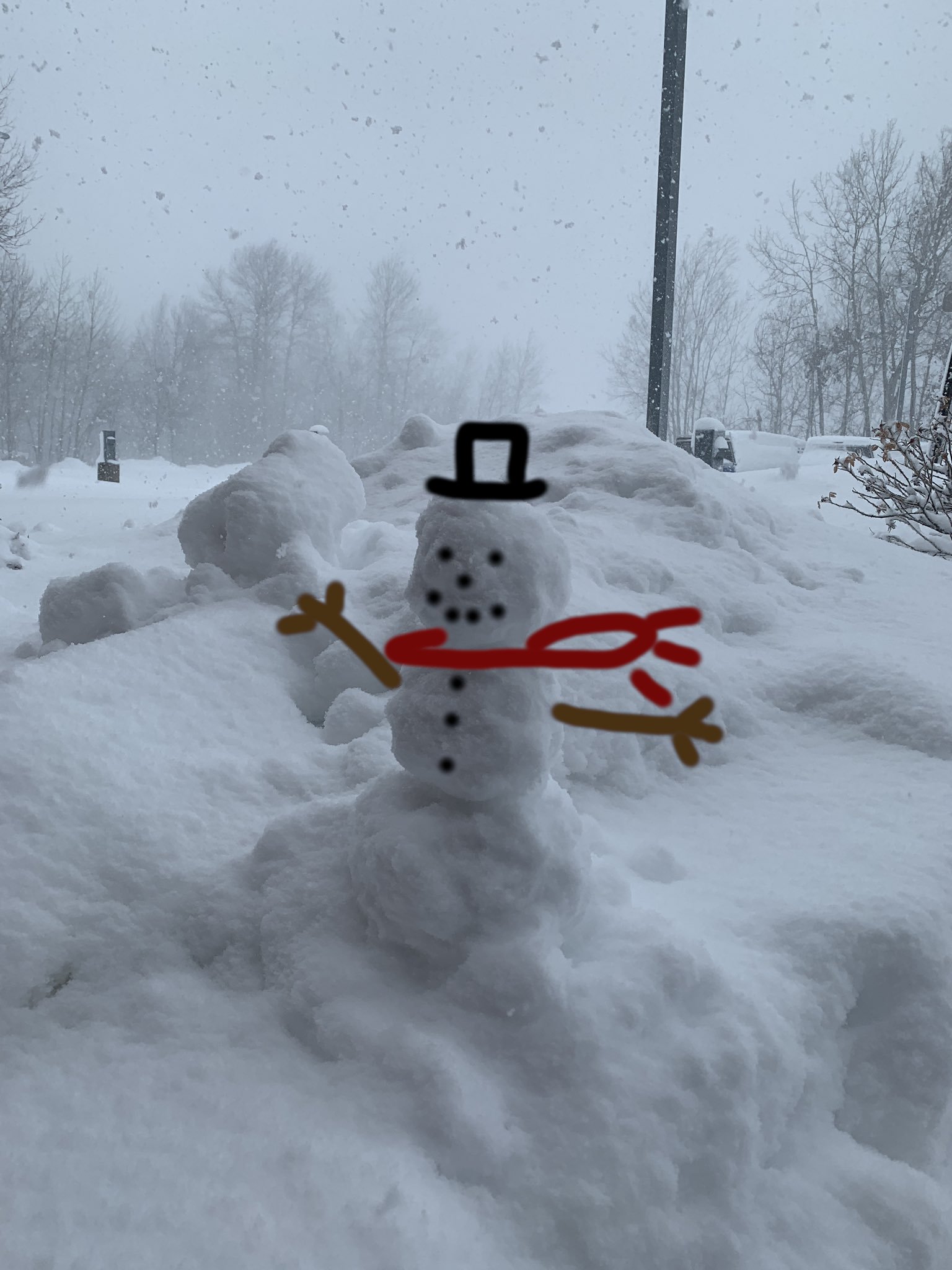 |
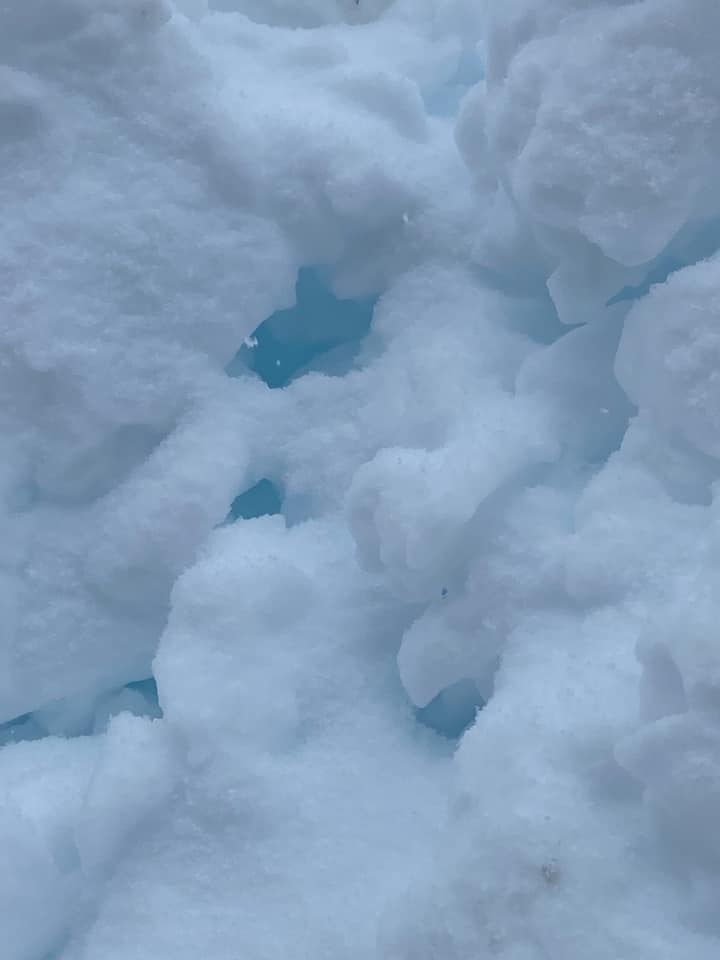 |
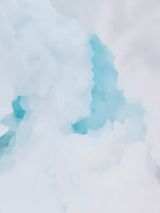 |
| Snowman at NWS Duluth |
Blue Snow!
(source: Ali Marie) |
More blue snow (source: Taryn Buckner) |
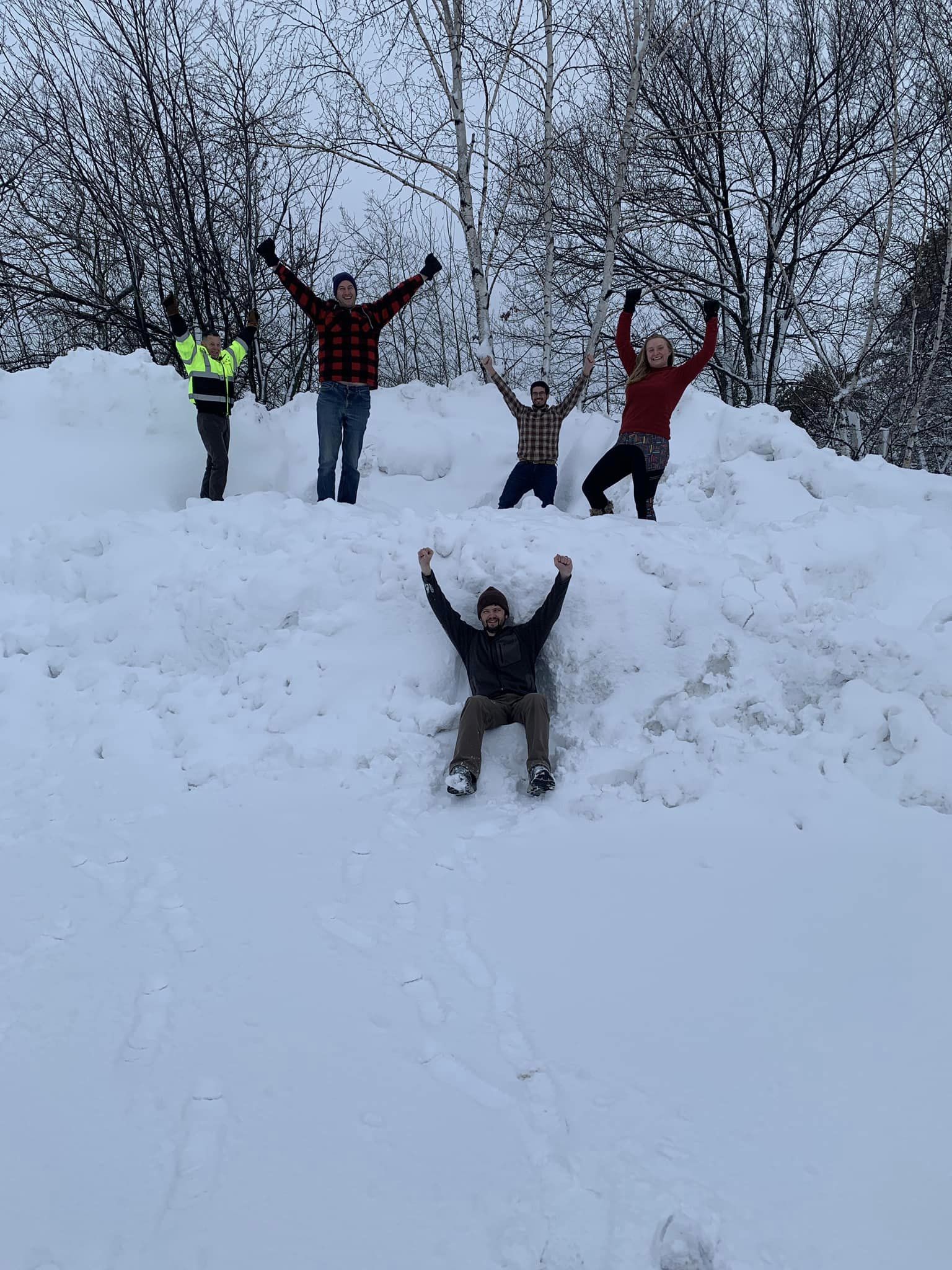 |
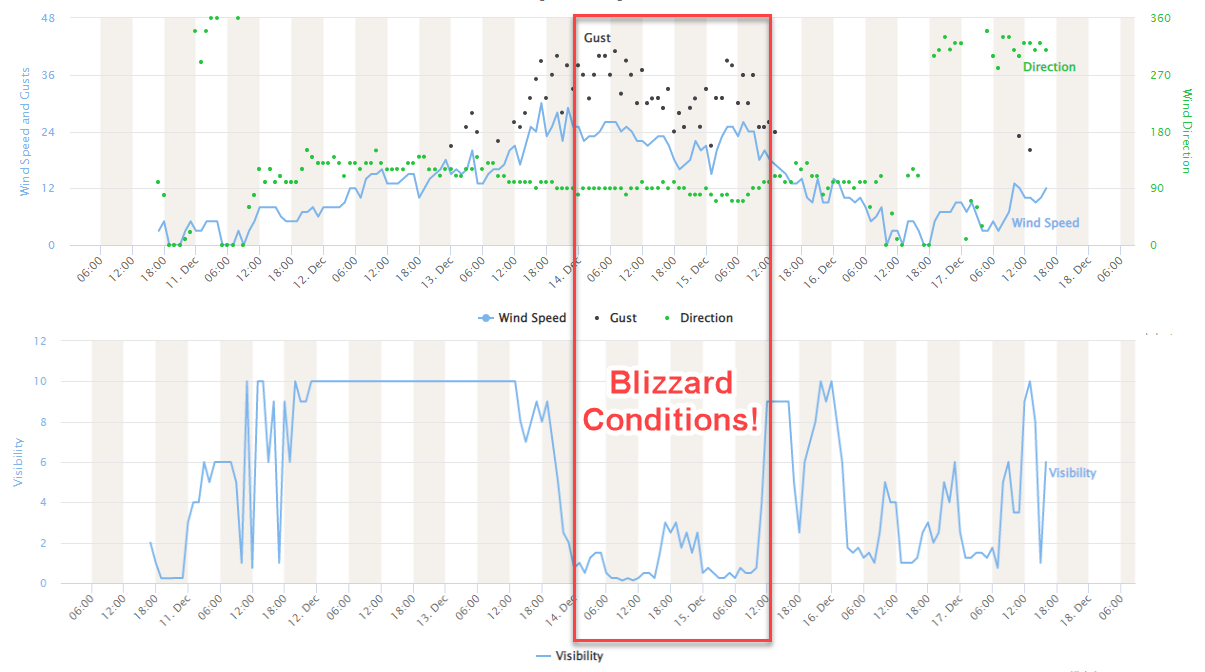 |
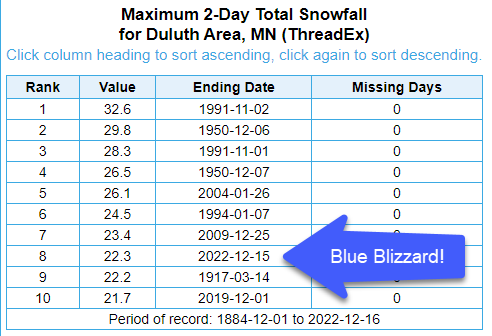 |
| 5 people slept at NWS Duluth overnight Wednesday night to ensure we were well staffed. Two of these stayed Tuesday night, as well! | Blizzard conditions were found at the Duluth Airport 6am-2pm Wednesday, and again 3am to 9 am Thursday. (KDLH ASOS) |
48 hour snowfall statistics -8th largest snowstorm! |
 |
 |
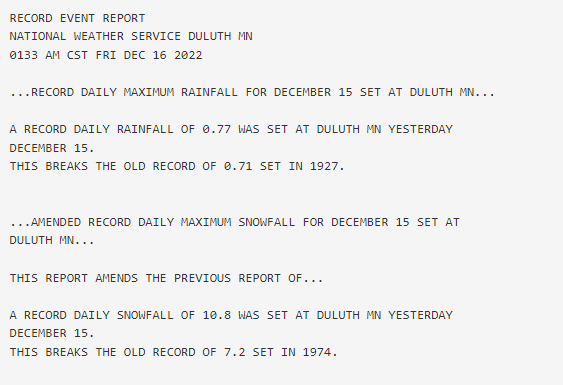 |
| More Blue Snow! (source: Tammy Sable) |
Record daily snowfall of 5.5 inches set at International Falls | Record daily snowfall 10.8 inches and rainfall 0.77 inches at Duluth, MN (NWS Duluth COOP report) |
Radar
Radar loops from the storm, mosaics of multiple radars. More information
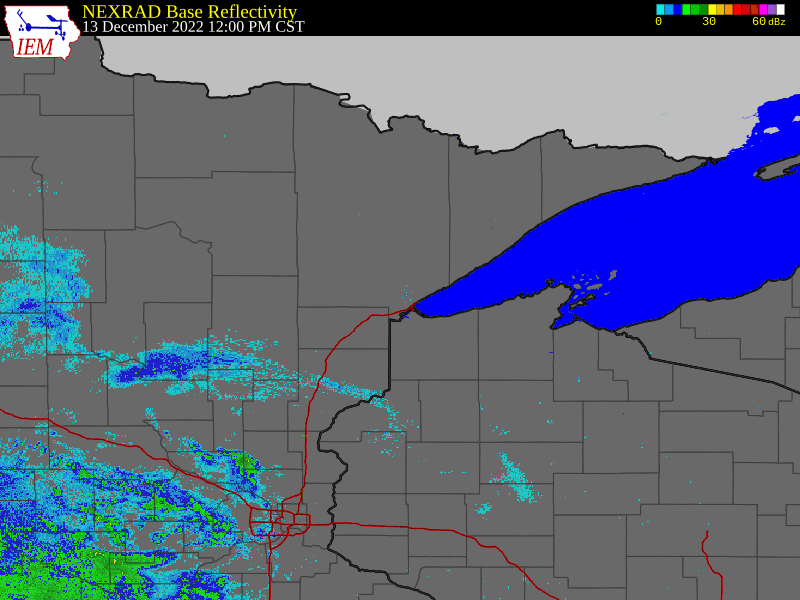 |
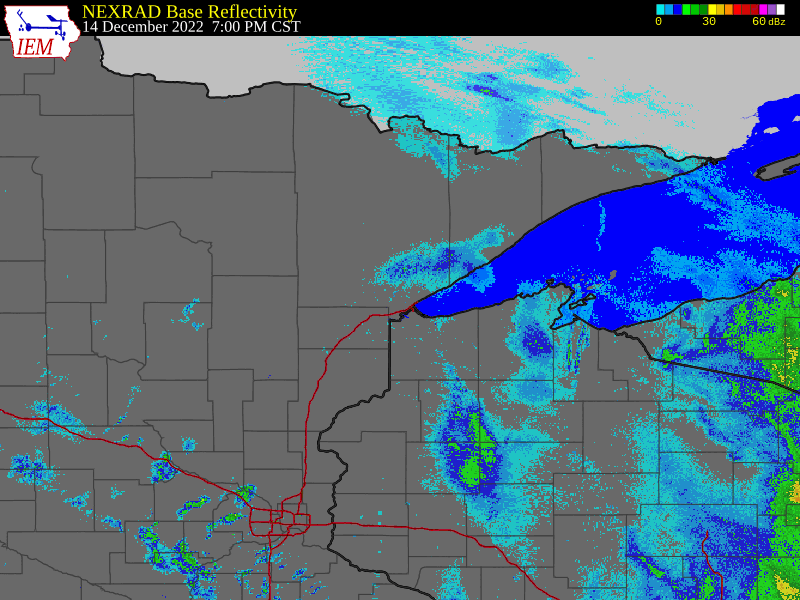 |
|
Radar Loop for our first wave of precipitation
Noon Tuesday December 13th until 7pm Wednesday December 14th
(courtesy Iowa Environmental Mesonet)
|
Radar Loop for the second wave of snow
7pm Wednesday December 14th to 2pm Thursday, December 15th.
(courtesy Iowa Environmental Mesonet)
|
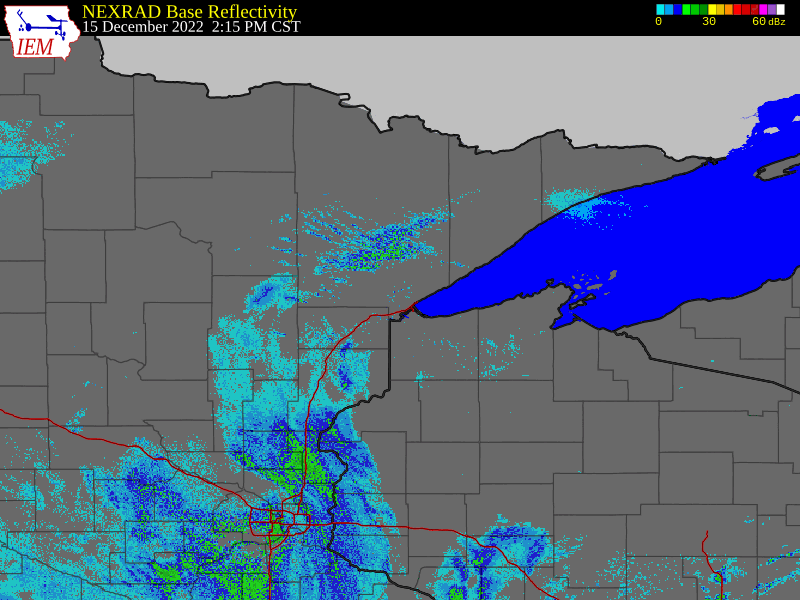 |
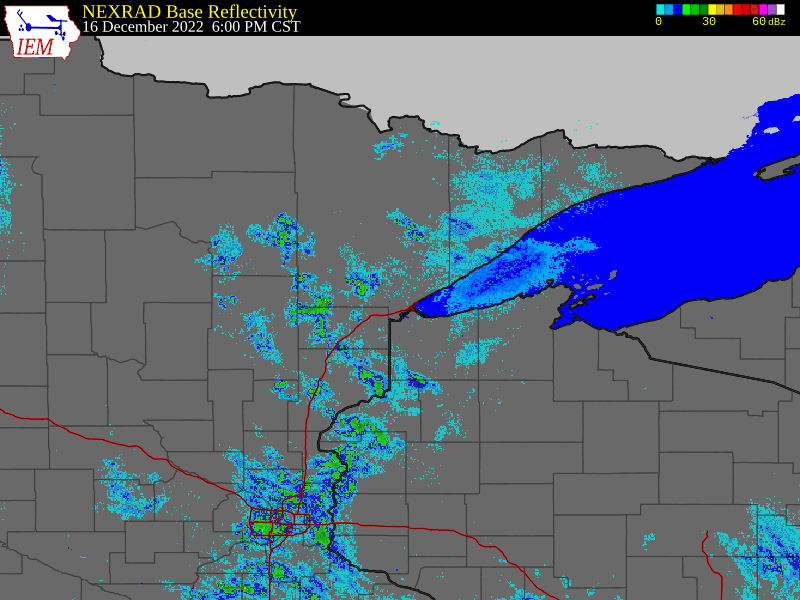 |
|
Radar Loop for lingering light-moderate snow
2pm Thursday, December 15th to 6pm Friday December 16th
(courtesy Iowa Environmental Mesonet)
|
Radar loop 6pm Friday, December 16th through 6pm Saturday December 17th
(courtesy Iowa Environmental Mesonet)
|
Environment
Insert synoptic summary.
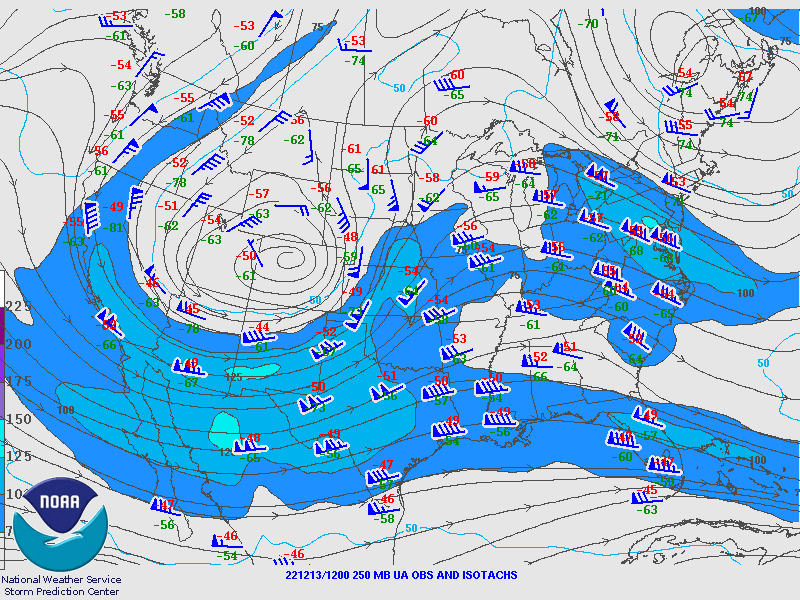 |
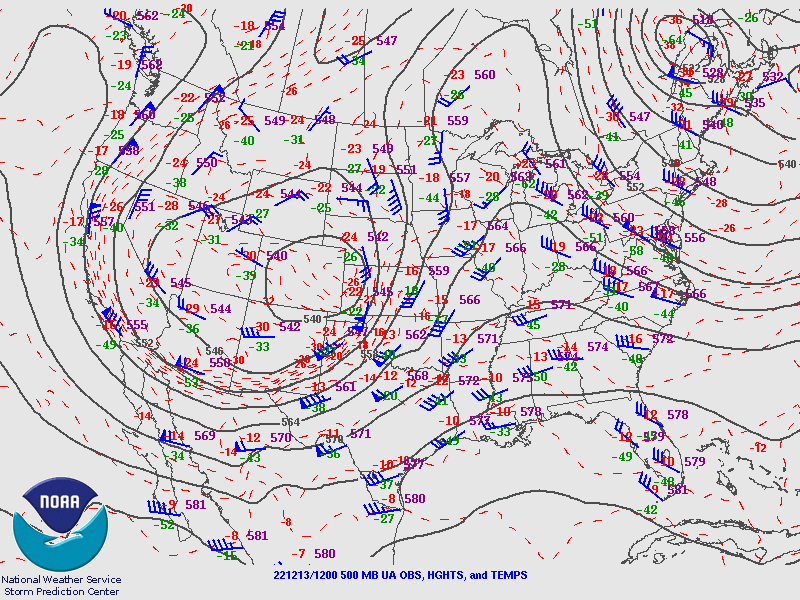 |
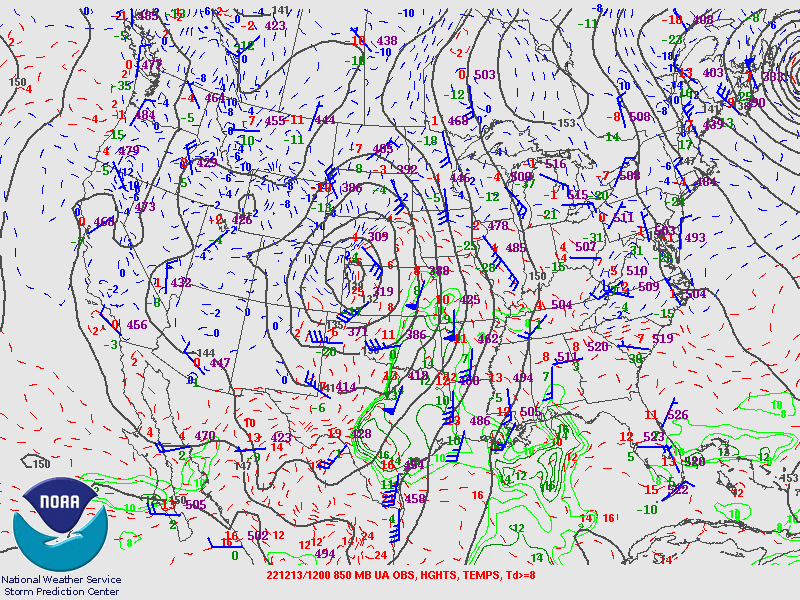 |
| Figure 1: 250 hPa SPC analysis | Figure 2: 500 hPa SPC analysis | Figure 3: 850 hPa SPC mesoanalysis |
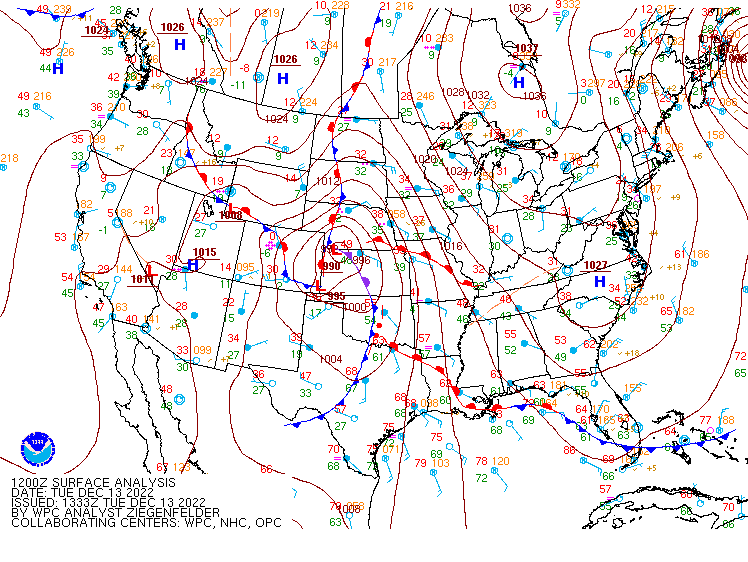 |
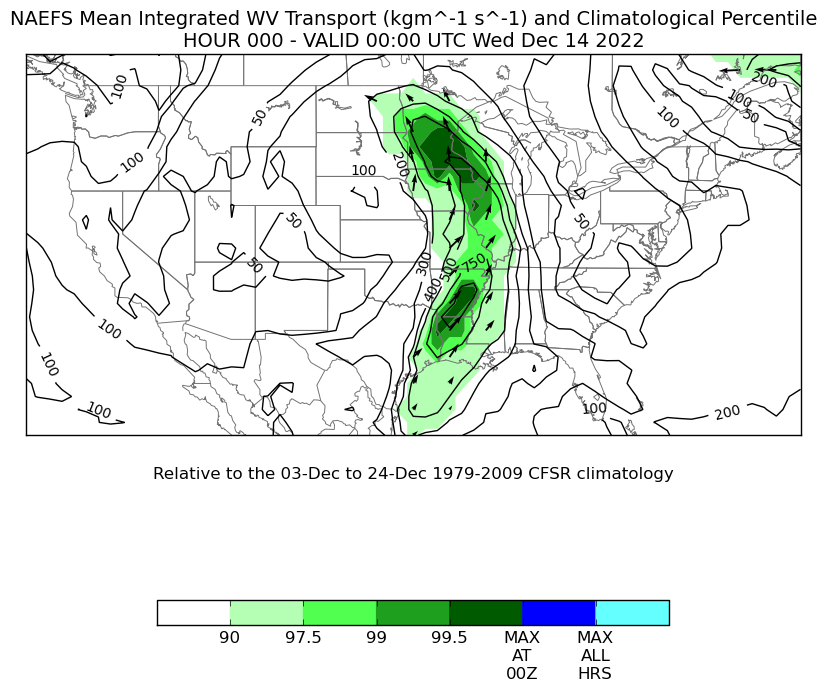 |
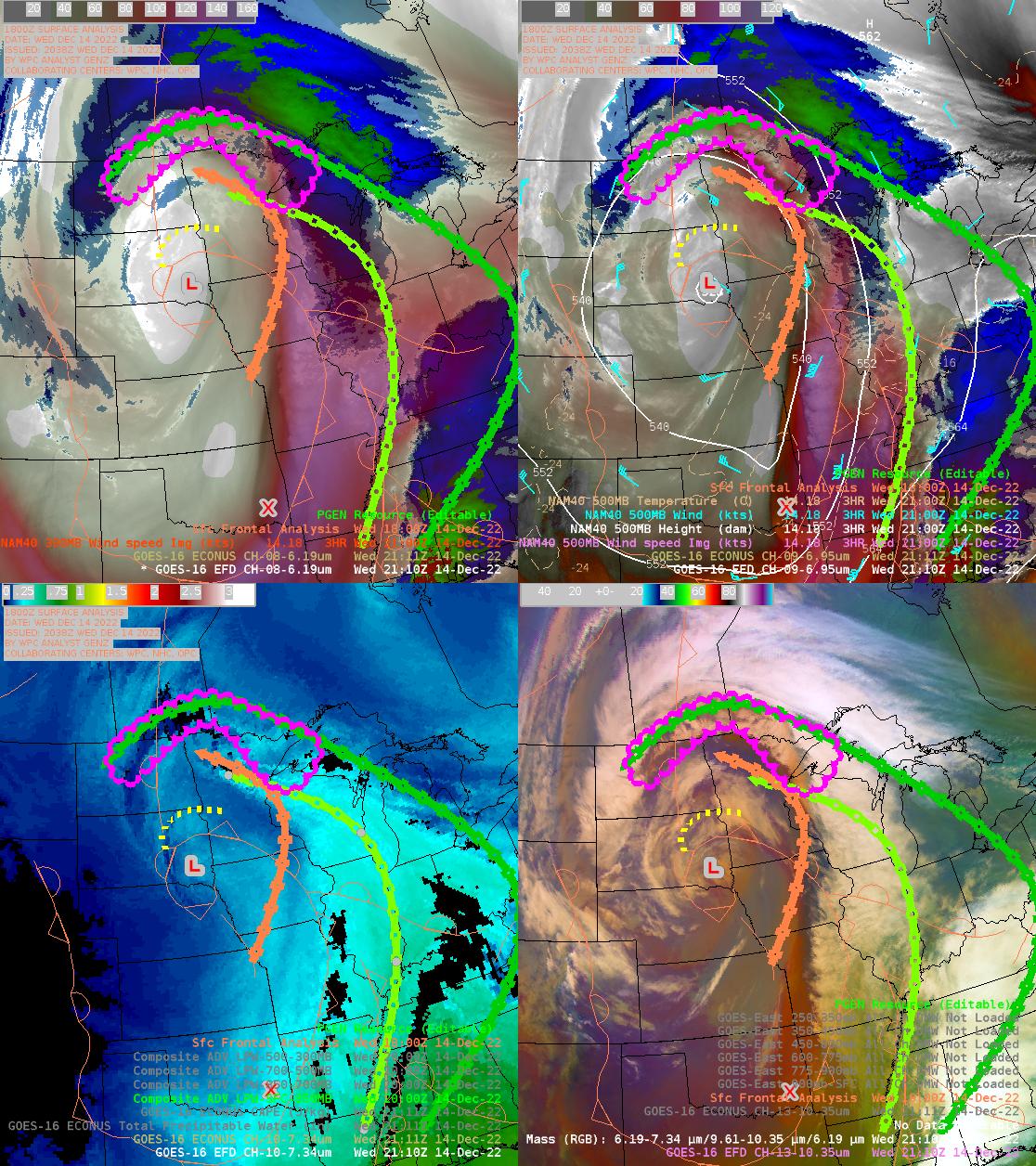 |
| Figure 4: Surface analysis | Figure 5: NAEFS Mean Integrated Water Transport 6PM Tuesday evening (forecast model) | Figure 6: A 4 panel of satellite imagery. Upper left: Upper Level Water Vapor with 300MB wind speeds. Upper right: Mid Level Water Vapor with 500mb height and winds. Lower right: Air Mass Satellite Imagery Lower left: Advected Layer Precipitable Water Imagery. On all 4 images, position of upper low (red L), Low level flow in orange, mid and upper level flow in light and medium green, respectively |
Additional environmental data.
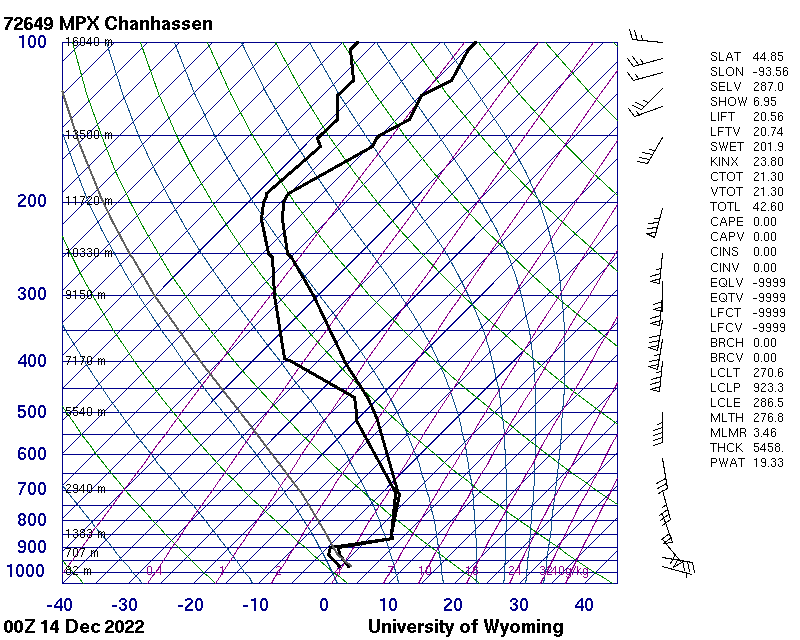 |
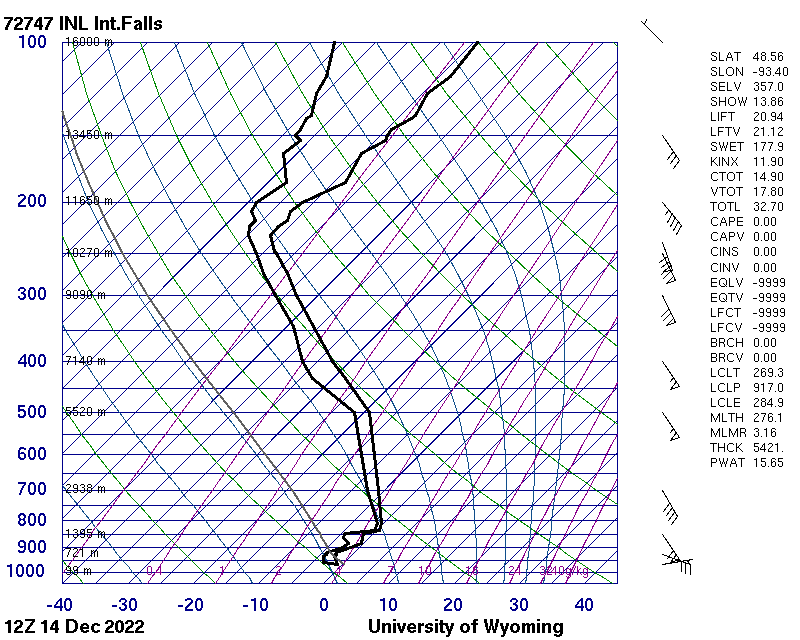 |
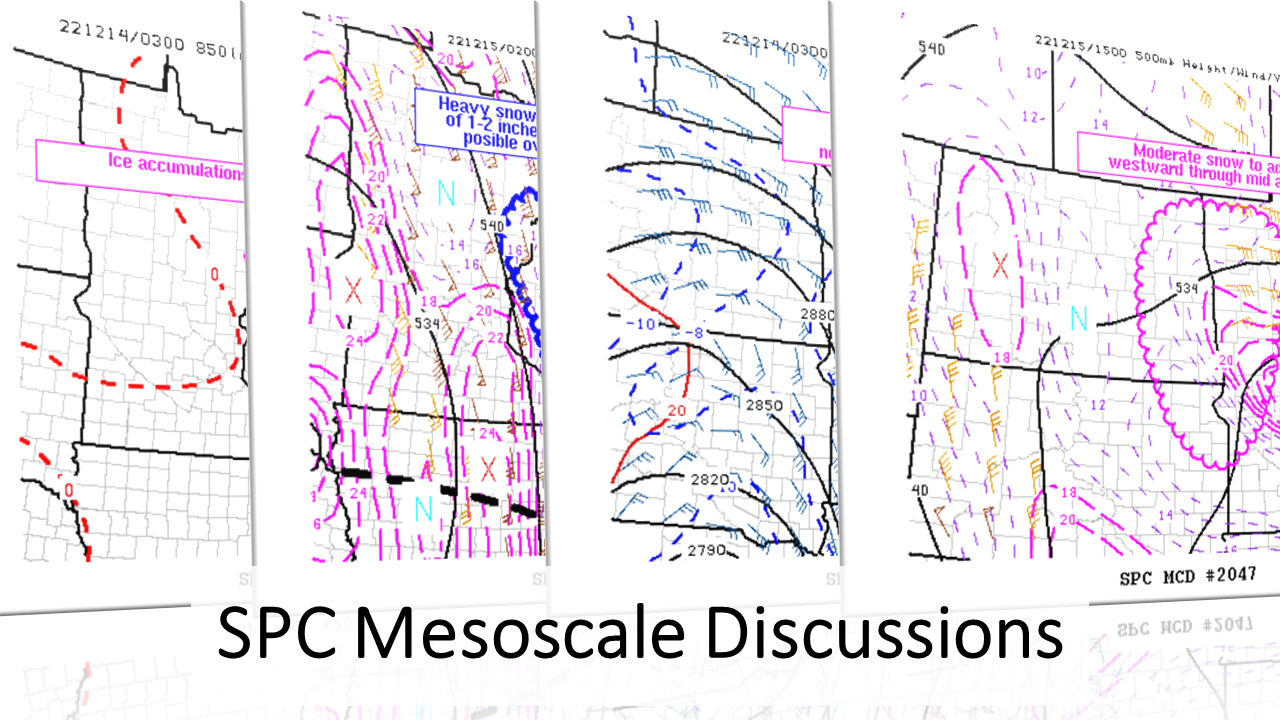 |
| Figure 7: MPX Chanhassen sounding from 6 PM December 13 2022 showing 19.33mm/0.75 in of Precipitable Water, a significantly above normal value. | Figure 8: INL International Falls sounding from 6 AM December 14 2022, showing 15.65mm/0.61 in of Precipitable Water, also significantly above normal | Figure 9: Numerous SPC Mesoscale Discussions were issued for this storm: 623 PM Tue Dec 13 1202 AM Wed Dec 14 406 AM Wed Dec 14 930 PM Wed Dec 14 1046 AM Thu Dec 15 |
Other environmental information and links:
A discussion of this storm from the Satellite Liaison Blog Note: discusses much of the central CONUS, not just the Northland
 |
Media use of NWS Web News Stories is encouraged! Please acknowledge the NWS as the source of any news information accessed from this site. |
 |